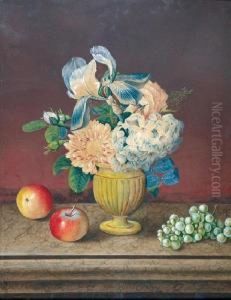Marie Nicole Vestier Paintings
Marie Nicole Vestier was a French painter born in 1767, during a period when the art world was predominantly male-dominated. Despite the societal constraints of her time, she managed to carve out a space for herself as an accomplished artist, primarily known for her portrait paintings. She was part of the prolific Vestier artist family, with her husband, Antoine Vestier, being a notable portraitist of the French Enlightenment. Her life and career were intertwined with the social and political upheavals that France experienced during her lifetime, including the French Revolution and the Napoleonic era.
Marie Nicole's works are characterized by their delicate brushwork and attention to detail, qualities that garnered her respect and recognition in the art circles of her time. She often portrayed her subjects with a sense of realism and sensitivity, capturing not just their physical likeness but also a glimpse of their personal character and social status. Despite the challenges faced by women in the arts during the 18th and early 19th centuries, Vestier managed to exhibit her works at the prestigious Salon de Paris, a significant accomplishment that highlighted her talent and determination.
Throughout her career, Marie Nicole Vestier created a body of work that offers valuable insights into the fashion, culture, and social dynamics of her time. Her portraits serve as historical documents, providing contemporary viewers with a window into the world of the French elite and middle class during a tumultuous period in the country's history. Despite her contributions to the art world, much of her life and work have remained relatively obscure, overshadowed by her male contemporaries. However, in recent years, there has been a growing interest in rediscovering and reevaluating the works of female artists like Vestier, acknowledging their contributions to the development of European art.
Marie Nicole Vestier passed away in 1846, leaving behind a legacy that is slowly being recognized and appreciated within the broader narrative of art history. Her paintings, once overlooked, are now being studied and exhibited as examples of the skill and resilience of women artists who navigated and succeeded within the constraints of their historical contexts.
